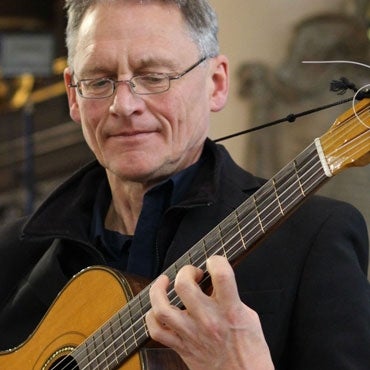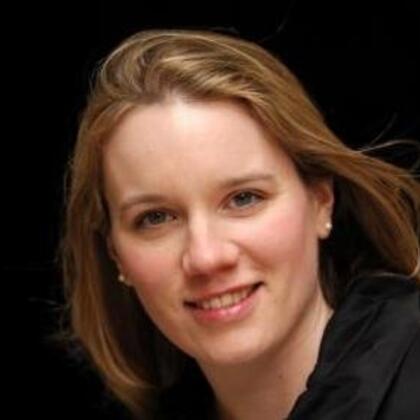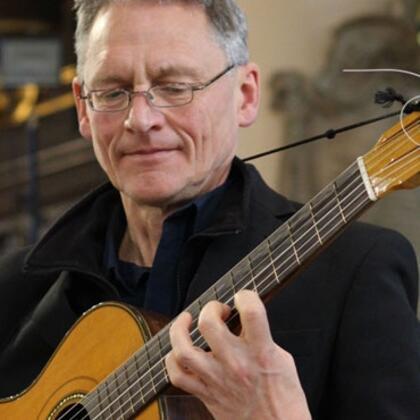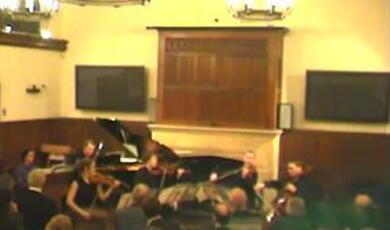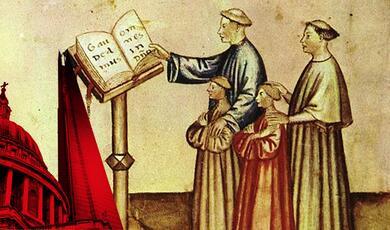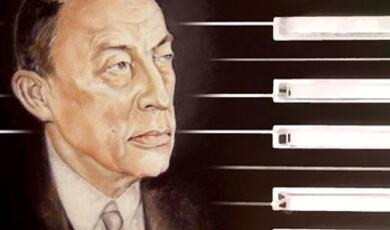The Guitar and 'the Fair Sex'
Share
- Details
- Text
- Audio
- Downloads
- Extra Reading
By the 1830s, caricaturists had begun to show the fashionable guitarist as a man’s instrument, but musical ability at the amateur level with guitar, harp or pianoforte was insistently gendered as female. The guitar, being a light, curvaceous and softly voiced instrument, was easily associated by the censorious, not always males, with the most vapid aspects of young female minds raised on restricted mental food or with an art of licensed seduction necessary for making successful marriages.
The discussion will broach the question, little explored, of whether the guitar, like the harp and pianoforte, was the subject of a campaign, in effect, to control the potency of musical art in a domestic context by associating it with the narrowed social and intellectual sphere that non-working women were encouraged to inhabit, and with a coquetry which the male viewer (and listener) was always at liberty to indulge or censure as he thought fit.
Download Text
23 April 2015
Men, Women and Guitars in Romantic England:
The Guitar and ‘the Fair Sex’
Professor Christopher Page
This lecture is dedicated to Lars Hedelius-Strikkertsen
The first page of the handout shows an illustration taken from one of the many books of instructions for the guitar that were published in London during the first half of the nineteenth century. This one dates from 1819. The author, Charles Sola, gives basic instructions, then provides a small anthology of pieces. You will have noticed at once that the performer, who must be an amateur since she is studing Sola’s book, is a woman. She is elaborately dressed, as if for a soirée in elite company, sitting on that most characteristic piece of Regency furniture, the sofa orchaise longue, where one could recline in a state of romantic reverie and indolence. To judge by this and other engravings to be found in the guitar tutors, such manuals were, like this one, mostly addressed to women.
In the judgement of some contemporaries, this association between the guitar and female amateurs meant that the instrument was quite unfit for men. This was part of a broader conviction, shared by many, that a gentleman should not stoop to perform any kind of music. Here is a passage from The Morning Post from December, 1829:
There is, we know, a common and very natural prejudice against men becoming musicians, and ardently as we are attached to the art, and impressed with its importance, we confess that we cannot see a man sit down to the piano, or take a guitar in his hand, without an involuntary feeling of degradation. (emphasis mine).
There could scarcely be a better illustration of the dangers we court when we suppose that anything in social customs or attitudes is ‘natural’. What appears evident and natural to one generation may seem odd and even offensive to their descendants when constructions of male and female identity have shifted, and especially (as today) when they are widely recognised as constructions and not eternal verities. My purpose today is explore the ways in which the guitar was associated with a female identity, and to examine the ways in which women used the guitar to achieve ends they were under pressure to accomplish, however that impulse might arise.
Throughout our period it was widely believed that women could bring to musical performance, as to much else, a free play of emotion, animated by feeling and sympathy. Men, in contrast, were associated with the rational powers they needed for their large fields of action, beyond the home, in commercial and political life. Many articulate women were quite prepared to endorse this view. Here, for example, is one of the most influential female writers of the period, and a major figure in the revival of evangelical Christianity in Britain, Hannah More (d. 1837) :
in all that captivates by imagery, or warms by just and affecting sentiment, women are excellent. They possess in a high degree that delicacy and quickness of perception, and that nice discernment between the beautiful and defective which comes under the denomination of taste. Both in composition and action they excel in details; but they do not so much generalize their ideas as men, nor do their minds seize a great subject with so large a grasp.
The second page of your handout shows an undated fashion plate, probably of the early 1800s, with two women performing an accompanied song for voice and guitar. Both women are dressed in light and diaphanous colours for high society, probably for a summer’s day. The singer, who raises her hand as if to express what Hannah More called ‘just and affecting sentiment’, is perhaps performing an Italian song, for as an essayist observed in 1821:
Italian song has a grace, a pathos, peculiar to itself; it flows as it were without effort from the lips, rising or falling in sighing slides, and sprinkled with emphatic appoggiaturas, now sinking into a low murmur, now swelling into firmness and vigour; and it is admirably assisted by the throbbing arpeggios, the full or feeble chords, and the silken notes of the indolent guitar…
Although many contemporary viewers, including many women, would have seen our fashion print as a celebration of women’s gifts – grace, emotional sensitivity and elegance – by right of gender, the musical talent of women was widely understood to be limited by what Hannah More calls that failure ‘to seize a great subject with so large a grasp’. The high level of proficiency that some women achieved on the piano, for example, taking lessons with masters such as the famous Kalkbrenner, did not modify the view expressed in a great many poems, novels and indeed fashion plates, that women show their excellence in music with a delicate touch on the harp, the piano or the guitar, or with a sentimental ballad, not by taking part in a string quartet or performing a concerto: the musical equivalent of ‘a great subject’, requiring a ‘larger grasp’.
‘Oh if my eyes deceive me not’, from May’s Instructions for the Spanish Guitar c1827-9
As you may have guessed, the story of women and their transactions with the guitar cannot be an entirely happy tale. When men made music in Romantic England, they often did so away from the home, playing ensemble works in gatherings whose history is deeply involved with the evolution of all-male clubs and societies from the seventeenth century onwards. A man went to such meetings with a melody instrument such as a violin, an oboe or cello, and he might expect to meet there a professional or two: perhaps a singing man from the local church or cathedral who was a good violinist, a versatile organist who played the bassoon. A woman, in contrast, might certainly have visitors, or indeed go visiting, and there could be music when she did, but it is highly revealing that the instruments insistently associated with women’s musical amateurism – the piano, the harp and the guitar – were all self sufficient and therefore suited to solitude, or if you prefer, to confinement. The vogue for the guitar, an instrument that yielded results relatively quickly to those of modest talent or ambition, was therefore related to a much more general and insidious narrowing of what woman were encourged to believe they could encompass, and of what life could offer.
By the 1830s, many families were wealthier than their grandparents had been, with the result that substantial numbers of women, especially among the middling sort, withdrew from the labour force. This does not mean that they ceased to work, for one can scarcely say that a wife who might spend four years of every five pregnant, and who supervised the running of a home, was not a working woman. Yet with prosperity came more domestic servants to bear some of the other burdens: housemaids, a nurse, a governess, a footman and a cook. To be sure, these could add much to wifely responsibilty, making the managment of a home a complex affair, but while a woman remained unmarried it could be very different. A Frenchman who visited Brighton in the early 1830s was astonished to find the young women of a wealthy family copying extracts from books on geography and history as part of their home education, but learning nothing connected with the running of a household. Perhaps they were exceptional, or he misjudged them, but it cannot be entirely wrong to suppose that there was a large population of unmarried women in comfortable homes with no task of greater importance than to gain a husband, or to while away of their lives if they found none. We meet one of the latter in Miss Volumnia from Bleak House, by Charles Dickens: she had ‘a pretty talent for cutting ornaments out of coloured paper, and also for singing to the guitar in the Spanish tongue…’, but not for much else.
The guitar had its place in the hunt for a husband. The third page of your handout shows a print of a young woman with a guitar, based upon a portrait by Chalon, exhibited in 1831. I venture to say that tastes have changed to the point where the picture now seems mawkish. The critic who reviewed the exhibition, however, found much to admire (although we should remember that he was looking at the original). He found that the picture reveals a woman ‘Elegant and coquettish, with an air of Gallic sprightliness…a fair fashionable, touching a guitar, and looking archly at the spectator. A roguish sparkle in her eye, and an answering smile upon her lip…the roses fancifully placed in the dark tresses have an agreeable effect’. Our critic is allowing himself to be drawn by an image of woman as seductress that is all the more tantalising for the deep male anxieties about female sexuality and allure that the image has the power to stir. How many young women, in search of a husband, took up the guitar to comply with this controlling male fantasy of womanhood seen without the dulling effects of age or marriage? What choice did they have if they did not wish to?
Many passages in poems, novels and serialised fiction extolled the virtues of the guitar-playing seductress, as in this passage from a novel of 1832 entitled The Schoolfellows:
Jacintha was esteemed, in Errington, a complete mistress of the instrument, and, in the opinion of all the neighbourhood, accompanied it with a voice of unparalleled sweetness, and withal could indulge, as she sang and played, in the most eloquent and seducing glances.
The posture of a seated woman with a guitar was considered to be very appealing indeed: elegant, and poised, with the curves of the one answering to the roundness of the other. The vogue for the guitar among women therefore arose in part from the constant subjection of women to a social gaze that was often sexual when it came from men, and highly competitive and critical when it came from women.
Here the guitar was deemed to have an advantage. Of the three instruments commonly associated with female amateurs the piano soon began to be disparaged after 1800 on the grounds that it made no show of posture. Thus according to an essay of 1811:
The attitude at a pianoforte, or at a harpsichord, is not so happily adapted to grace. From the shape of the instrument, the performer must sit directly in front of a straight line of keys and her own posture being correspondingly erect and square, it is hardly possible that it should not appear rather inelegant.
It was otherwise with the guitar. So in a pen portrait of a woman from 1802:
As her voice was charming in itself, so was it improved by art, and aided by the soft touches of the guitar, which she handled with inimitable grace, and preferred to all other instruments, as the attitude of playing upon it is most advantageous for the discovery of a fair lady’s gentility.
The final page of your handout shows a caricature by William Heath, published in London around 1828. A man and a woman who are fashionably dressed (indeed overdressed; that is part of the satire) are shown performing the very song we heard a few moments ago: Hope Told a Flattering Tale. The soloist is male; he stands, and is evidently enjoying some freedom of movement. In contrast the accompanist, the lady with the guitar, thoigh sitting upright, seems very poised.
Nel cor più non mi sento/Hope told a flattering tale
From F. Chabran, Complete set of Instructions for the Spanish Guitar 1810
There was much contemporary comment designed to encourage women to see themselves in this way. Here is a passage from 1827, a review of recent publications:
We cannot help observing the powerful inducement to ladies to learn the guitar, which the publisher has ingeniously added to the author's preface. "For the display of graceful attitude, the guitar is admirably well calculated, and when in the hands of an accomplished female, a skilful performance on it gives fascination to beauty by affording such opportunities for uniting graceful action to elegance of person, as perhaps no other instrument possesses." Can any lady resist these instances, and not purchase Mr. Lindsay's publication in gratitude for such a recommendation?
The lived experience of women – their inner life as amateurs of the guitar from day to day – is hard to perceive beneath the many and varied attempts to regulate and shape female behaviour. Too many of the sources we possess were written by fathers, husbands or brothers in a spirit of correction, satire or sheer mysyogyny, or by women who imitated, often anonymously, the printed voice of their dominant male counterparts. In too many self-satisfied essays and novels, male writers parody what they find to be the vacuous speech of young daughters who, as it may now seem to us, had sometimes been systematically starved of the education they needed to do better.
Another problemwith many of our documents, especially poetry and fiction, is the sentimentality with which women and their needs were often imagined, combined with an impoverished sense of how a woman might live an autonomous and nourishing existence without either loneliness or langour. A woman abandoned, alone or somehow isolated, without comforts, was a favourite theme of contemprary fiction, as every reader of Jane Eyre knows, but it flows over the boundaries of fiction into social commentary. One author in 1829, for example expressed herself very much in favour of women having accomplishments such as some ability with harp or guitar, for
Sometimes, a husband is obliged to be frequently, and for long periods, absent from home; sometimes, there are no children to interest the feelings, and occupy the time and attention of the married woman;—in such cases, her acquirements and information may be as companions to her, whiling away the hours of solitude, which would, otherwise, be spent in listlessness, indolence, and discontent.
This seems both earnest and pragmatic, but there is more than a shadow here of the ennui that besets Tennyson’s Mariana, from a later period, who lives alone in a neglected house while waiting for a lover who never comes :
WITH blackest moss the flower-plots Were thickly crusted, one and all: The rusted nails fell from the knots That held the pear to the gable-wall. The broken sheds look'd sad and strange: 5 Unlifted was the clinking latch; Weeded and worn the ancient thatch Upon the lonely moated grange. She only said, 'My life is dreary, He cometh not,' she said; 10 She said, 'I am aweary, aweary, I would that I were dead!'
That woman really needs a guitar !
All she had to do was buy one and look through a local music shop, for a large quantity of melodious and appealing song that was published or voice and guitar, some of it in the method books, predominantly addressed to women, that I discussed a little while ago. Here is ‘Oh if my eyes deceive me not’, from May’s Instructions for the Spanish Guitar c1827-9.
‘Oh if my eyes deceive me not’, from May’s Instructions for the Spanish Guitar c1827-9 Second performance
The accompaniment to that piece was relatively straightforward, but some women undoubtedly reached a very high standard on the guitar, confounding the notion that the guitar, like sweet wine, ‘was a good sort for ladies’. Already by 1814 a novel had been published, entitled The Spanish Guitar, whose main theme seems to be (and I quote): ‘Music is an engaging and now too fashionable a science; but, like other things, it is often perverted; for young ladies, who used to amuse their friends by a few simple songs, now perform like professors’.
At a more modest level of achievement, the guitar had a secure place in the culture of thetre and opera songs, valued by many and probably the musical food that most middle class homes preferred to consume on a regular basis, despite what a newly emergent breed of newspaper critics might maintain about the infinite superiority of the recent great masterworks of the German tradition by Beethoven and others. There were even those prepared to oppose the critics on their own ground:
But this instrument (the piano) the least interesting of all in its tones, is costly and cumbrous, requires immense practice to excel on, and with common playing is not worth listening to. As an accompaniment for the voice, it has not half the beauty of more facile ones; and vocal music has such fascination, that even a trifling air with the guitar would, in ninety-nine instances out of a hundred, draw away the listeners collected round an exhibitor of Beethoven's crudities on one of ———'s hundred-and-fifty guinea rose-wood, brass embossed, six octaved Grand Pianos.
Beethoven’s crudities !
In an attempt to get closer to the actual experience of women with the guitar, I would like to spend the last part of this lecture looking in one particular direction: at the adoption of the guitar by members of the governess class. By a governess I mean a woman who resided with a family as a teacher of languages, and of accomplishments such as drawing and music, or who visited families to perform those duties for an hour to two at a time, called day governesses. Both kinds were prominent in early-nineteenth century England, whence their strong presence in fiction with characters such as Becky Sharp in Thackery’s Vanity Fair, Mrs. Weston and Jane Fairfax in Jane Austen’s Emma, and of course Jane Eyre. In some respects, governesses were not always easy to distinguish from schoolmistresses, and a good position in a school was what many young women, seeking a position as a governess, would probably have preferred. There was no question then of being treated condescendingly by the matriarch of a family or facing the hostility of domestic servants below stairs who might regard a governess as a woman who gave herself airs but was actually no better than themselves. As one servant says to another in Vanity Fair: ‘I don't trust them governesses; they give themselves the hairs and hupstarts of ladies, and their wages is no better than you nor me.’
How do we know about these women ? A great many of them advertised in the newspapers, and gave an address where enquiries might be made. A woman could arrange with a bookseller, a local post office, a stationer or a music shop to serve as the reply address, or she could devise an advertisement and leave it for collection in one of the recognised collection points, often a coffee shop. Many of the bookshops that the women used were located in prestigious areas such as Kensington, Pall Mall or New Bond Street, suggesting the kind of clientele that they hoped to attract. Unfortunately, they never give their names. In common with standard practice at the time, they merely give initials, often patently false, such as ABC or XYZ. The 1830s, remember, was the decade of The Boarding House, by Charles Dickens, where Mrs. Tibbs places an advertisement for lodgers and ‘Answers out of number were received with all sorts of initials; all the letters of the alphabet seemed to be seized with a sudden wish to go out boarding and lodging… most profound was the secrecy observed’. As Dickens says, such business was generally conducted behind a curtain of anonymity as a matter of social custom and discretion.
Nel cor più non mi sento/Hope told a flattering tale. Second performance,
From F. Chabran, Complete set of Instructions for the Spanish Guitar 1810
The avertisements show that most of our governess guitarists were in their early twenties, and ‘A German lady, about 26 years of age’ is the oldest that I have been able to find. As for their backgrounds, when a woman gives a bookseller’s shop as the reply address, we can go no further, but sometimes they give a private address. With the aid of contemporary directories and other documents it is possible to pursue many of these, and the results attest to a massive constituency for the guitar in homes of the middling sort. The addresses, onve we hunt them down, include the house of a boot-maker, a middle-rank married householder with footman, parlour maid and cook; there is the house of a surgeon, a parson, a carpenter, a trunk and Venetian blind maker, a wholesale hosier, a turner and toymaker; there is a china and glassman, a head waiter at a hotel, ‘a geographical engineer and surveyor’, a corn factor, a solicitor and a wine, spirit and liaueur merchant. Some give provincial addresses (Thame, Southampton, Post Office at Bungay in Suffolk and Bath) but the vast majority are here in London, ranging from Cheapside, St. Dunstan’s Hill and Holborn to the suburbs such as Pentonville, the houses round the Hampstead Road and Chelsea. There is quite a strong showing from south of the river: Kennington Lane, Clapham, Lambeth, Wapping, Stockwell, Brixton, Walworth and Camberwell.
Teaching, whether as a governess or schoolmistress, was one of the few paid occupations a woman could pursue and remain a lady. When undertaken by a woman, it was widely regarded as a fundamentally maternal process: an expression of a woman’s natural role as a mother. A woman might have many reasons for needing the income she could get as a governess : the risky investments of a husband, brother or son ; overextended credit leading to spectacular bankruptcies; bereavement, loss of parents, desertion and widowhood. One of our governess guitarists, for example, says openly in her advertisement she has ‘recently lost her surviving parent’. Another loftily (and perhaps truthfully) announces that she ‘was born and educated to superior expectations’ but has been compelled by circumstances to advertise for a position. Yet another says she has been ‘recommended a change of climate’ on medical grounds and would prefer an engagement with a family in Italy, the South of France or Madeira. Many women hoped to secure a home in the medium term where they might be treated with consideration and respect. One of our guitarists placed an advertisement in 1832 announcing that she possessed a small independence, that is to say a small income of her own, and therefore; emolument is not so much the object as a comfortable home’. Another, in 1835, says ‘she would be happy to engage herself without a salary, with a family going to the Continent; her travelling expenses being allowed her, together with the opportunity of accompanying the family to various places they might think worthy of notice’. There is a wealth of humiliation and unhappiness, known to many a governess, behind that modestly expressed wish to be treated with consideration and included in the family’s travelling plans
Our governess guitarists were seeking paid work, which means a measure of independence, at a time when many historians have seen a narrowing of middle-class women’s opportunities outside the home and domesticity. A place as a governess, which was essentially a position as teacher and childminder, could often be fraught with misery and unhappiness, but it was nonetheless a developing source of employment for women in early-nineteenth century Britain. In that regard the rising fashion for the Spanish guitar in the 1820s and 1830s was not necessarily a source of confinement, turning women yet further into caged songbirds in their own homes, though that is arguably the impressions that some of the images in the guitar methods give, showing female players in decorative poses and evening gowns. Instead, the guitar was a means, when added to others, to secure some income and at least a limited autonomy. Governesses with musical knowledge, and an ability to teach musical instruments, were amongst the most favoured of their class; in Jane Austen’s novel Emma Mrs Elton says to Jane Fairfax: ‘Your musical knowledge alone would entitle you to name your own terms, have as many rooms as you like, and mix in the family as much as you chose…’
Some of our goverenesses claim to be quite advanced players. One from 1820 advertises herself as ‘completely mistress’ of guitar, while another from 1828 announces that she ‘excels as guitarist’.One woman, advertising in March 1829, describes herself as a MUSICAL GOVERNESS, and ‘a late pupil of Kalkbrenner’,the famous pianist, and says that she has presided at the piano forte ‘with distinguished success at private concerts on the Continent as well as in this country’. She also give notice that she can give ‘finishing instruction on the Spanish guitar’.
Among the governesses who offered the Spanish guitar, usually with singing, but with no other musical accomplishment, we find a suprising number who were, or who claimed to be, French immigrants, and a number of British women who claimed to have passed a considerable amount of time in France usually Paris. Other advertisements offer the guitar and pianoforte (this is auite common) or the guitar, pianoforte and singing. More broadly, many of our governesses were also offering to teach French and Italian, often used in published songs, but Spanish, curiously enough, is very rare. Three of our governesses even offered to teach Latin, which is a decidedly genteel touch for the daughters of professional men : the doctors, surgeons, lawyers and others whose daughters had the liberty to browse in a large paternal library.
In just one example, I can lift the veil of anonymity. Unlike the majority of women who advertised for a post as governess, a certain M. K., who advertised in 1833, did not pay a stationer or a bookseller to receive her replies; instead, she decided to identify her family home in a genteel auarter of London: 17 Foley Place, Cavendish Square. The Blue Book for 1833, a directory of London gentry and aristocracy, lists the occupier of this house in 1833 as a surgeon named George Knowles. His Will, proved on 24 October 1838, describes him as an apothecary with two daughters, Jane and Martha. So the governess in this advertisement, M. K. of 1833, who hoped to teach the guitar as a governess, must be Martha Knowles.
In 1812, the year Napoleon hurled his army against Russia, Martha was baptized in the nonconformist Scotch Church in Wells Street, so she came from a dissenting family. She was therefore about twenty-one years’ old when she placed her advertisement. Her musical talents with pianoforte and guitar were clearly somewhat advanced; her advertisement shows that she was willing to give ‘instruction in the pianoforte and guitar alone’, which sounds like a bid to broaden her options beyond a strictly private and domestic context to a boarding school. Her father, being an apothecary and surgeon, was approximately the equivalent of a general practitioner today; it was not an especially genteel occupation, as anyone who knows the kind of scorn directed against another apothecary, the poet John Keats, will recognize, but it was a profession.
I end with an enigma. It is remarkable how little historical context our sources can offer for a striking advertisement that appeared in an issue of The Times for 1827. This announces that two sisters have taken lodgings and now invite applications from three or four ladies who might wish to share the accommodation with them, ‘their object being society, and not emolument’. All applicants, if accepted, will have the use of a harp, guitar and pianforte. Here are women evidently as yet unmarried, and perhaps with no intention of becoming so, who wish to live companionably with other women, and to enjoy music at home. In such a context as this, it remains uncertain what the ability of the guitar to give ‘fascination to beauty’, or to make a woman appear as a ‘tuneful treasure’, would have meant.
© Professor Christopher Page, 2015
This event was on Thu, 23 Apr 2015
Support Gresham
Gresham College has offered an outstanding education to the public free of charge for over 400 years. Today, Gresham College plays an important role in fostering a love of learning and a greater understanding of ourselves and the world around us. Your donation will help to widen our reach and to broaden our audience, allowing more people to benefit from a high-quality education from some of the brightest minds.


 Login
Login


